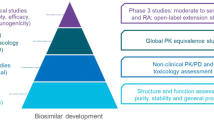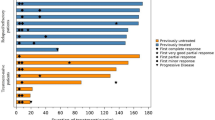Abstract
As part of its Single Technology Appraisal process, the UK National Institute for Health and Care Excellence (NICE) invited the manufacturer of ibrutinib (Janssen) to submit evidence on the clinical effectiveness and cost effectiveness of ibrutinib for the treatment of relapsed or refractory (R/R) mantle cell lymphoma (MCL). The School of Health and Related Research Technology Assessment Group at the University of Sheffield was commissioned to act as the independent Evidence Review Group (ERG). The ERG produced a critical review of the evidence contained within the company’s submission to NICE. The clinical effectiveness evidence for ibrutinib included one randomised controlled trial comparing ibrutinib and temsirolimus and two single-arm studies. The company’s indirect comparison of ibrutinib versus rituximab plus chemotherapy (R-chemo) produced a hazard ratio (HR) for progression-free survival (PFS) of 0.28. The ERG’s random effects network meta-analysis (NMA) indicated that the treatment effect on PFS was highly uncertain (HR 0.27; 95% credible interval (CrI) 0.06–1.26). The company’s Markov model assessed the cost effectiveness of ibrutinib versus R-chemo for the treatment of R/R MCL from the perspective of the National Health Service (NHS) and Personal Social Services over a lifetime horizon. Based on a re-run of the company’s model by the ERG, the incremental cost-effectiveness ratio (ICER) for ibrutinib versus R-chemo [including the company’s original patient access scheme (PAS)] was expected to be £76,014 per quality-adjusted life-year (QALY) gained. The ERG had several concerns regarding the company’s model structure and the evidence used to inform its parameters. The ERG’s preferred analysis, which used the ERG’s NMA and the observed Kaplan–Meier curve for time to ibrutinib discontinuation and excluded long-term disutilities for R-chemo, produced ICERs of £63,340 per QALY gained for the overall R/R MCL population and of £44,711 per QALY gained for patients with one prior treatment. Following an updated PAS and consideration of evidence from a later data-cut of the RAY trial, the appraisal committee concluded that the most plausible ICER for the one prior treatment subgroup was likely to be lower than the company’s estimate of £49,848 per QALY gained. The company’s ICER for the overall R/R MCL population was higher, at £62,650 per QALY gained. The committee recommended ibrutinib as an option for treating R/R MCL in adults only if they have received only one previous line of therapy and the company provides ibrutinib with the discount agreed in the commercial access agreement with NHS England.

Similar content being viewed by others
References
National Institute for Health and Care Excellence. Guide to the processes of technology appraisal. London: NICE; 2014. https://www.nice.org.uk/process/pmg9/chapter/foreword. Accessed 01 Apr 2018.
Tappenden P, Simpson E, Sanderson J, Pollard D, Clowes M, Kaltenthaler E, et al. Ibrutinib for treating relapsed or refractory mantle cell lymphoma: a single technology appraisal. Sheffield: University of Sheffield; 2016. https://www.nice.org.uk/guidance/ta502/documents/committee-papers. Accessed 04 Mar 2018.
National Institute for Health and Care Excellence. Ibrutinib for treating relapsed or refractory mantle cell lymphoma: final appraisal determination. London: NICE; 2017. https://www.nice.org.uk/guidance/ta502/documents/final-appraisal-determination-document. Accessed 01 May 2018.
National Institute for Health and Care Excellence. Ibrutinib for treating relapsed or refractory mantle cell lymphoma: technology appraisal guidance. London: NICE; 2017. https://www.nice.org.uk/guidance/ta502. Accessed 01 May 2018.
National Institute for Health and Care Excellence. Ibrutinib for treating relapsed or refractory mantle cell lymphoma. London: NICE; 2017. https://www.nice.org.uk/guidance/ta502. Accessed 01 June 2018.
Janssen Ltd. Ibrutinib for the treatment of relapsed or refractory mantle cell lymphoma. Company’s evidence submission to the National Institute for Health and Care Excellence. High Wycombe: Janssen; 2016. https://www.nice.org.uk/guidance/ta502/documents/committee-papers. Accessed 04 Mar 2018.
McKay P, Leach M, Jackson R, Cook G, Rule S. Guidelines for the investigation and management of mantle cell lymphoma. Br J Haematol. 2012;159:405–26.
Dreyling M, Thieblemont C, Gallamini A, Arcaini L, Campo E, Hermine O, et al. ESMO consensus conferences: guidelines on malignant lymphoma. Part 2: marginal zone lymphoma, mantle cell lymphoma, peripheral T-cell lymphoma. Ann Oncol. 2013;24(4):857–77.
National Institute for Health and Care Excellence. Ibrutinib for treating relapsed or refractory mantle cell lymphoma: final scope. London: NICE; 2016. https://www.nice.org.uk/guidance/ta502/documents/final-scope. Accessed 01 Apr 2018.
Janssen Ltd. Ibrutinib for treating mantle cell lymphoma. Company’s response to clarification questions from the ERG. High Wycombe: Janssen; 2016. https://www.nice.org.uk/guidance/ta502/documents/committee-papers. Accessed 04 Mar 2018.
Dreyling M, Jurczak W, Jerkeman M, Silva RS, Rusconi C, Trneny M, et al. Ibrutinib versus temsirolimus in patients with relapsed or refractory mantle-cell lymphoma: an international, randomised, open-label, phase 3 study. Lancet. 2016;387(10020):770–8.
Wang ML, Rule S, Martin P, Goy A, Auer R, Kahl BS, et al. Targeting BTK with ibrutinib in relapsed or refractory mantle-cell lymphoma. N Engl J Med. 2013;369(6):507–16.
Wang M, Goy A, Martin P, Ramchandran R, Alexeeva J, Popat R. Efficacy and safety of single-agent ibrutinib in patients with mantle cell lymphoma who progressed after bortezomib therapy. In: 56th American Society of Hematology (ASH) annual meeting and exposition, San Francisco, 6–9 Dec 2014.
Hess G, Herbrecht R, Romaguera J, Verhoef G, Crump M, Gisselbrecht C, et al. Phase III study to evaluate temsirolimus compared with investigator’s choice therapy for the treatment of relapsed or refractory mantle cell lymphoma. J Clin Oncol. 2009;27(23):3822–9.
Carter GC, Liepa A, Zimmerman AH, Morschhauser F. Validation of the Functional Assessment of Therapy—Lymphoma (FACT-LYM) in patients with relapsed/refractory mantle cell lymphoma. (Abstract 2376). Blood. 2008;112:828.
Forstpointner R, Dreyling M, Repp R, Hermann S, Hänel A, Metzner B, et al. The addition of rituximab to a combination of fludarabine, cyclophosphamide, mitoxantrone (FCM) significantly increases the response rate and prolongs survival as compared with FCM alone in patients with relapsed and refractory follicular and mantle cell lymphomas: results of a prospective randomized study of the German Low-Grade Lymphoma Study Group. Blood. 2004;104(10):3054–71.
Haematological Malignancy Research Network. Clinical management and outcome in mantle cell lymphoma—version 1.4. York: HMRN; 2016.
Janssen Research and Development. Data on File—Imbruvica (ibrutinib)—pooled analysis [data held on file]. High Wycombe: Janssen; 2016.
Janssen Research and Development. RAY (MCL3001) Clinical Study Report. High Wycombe: Janssen; 2015.
Janssen Research and Development. SPARK (MCL2001) Clinical Study Report. High Wycombe: Janssen; 2014.
Haymarket Media Group. Monthly Index of Medical Specialties (MIMS); 2016. https://www.mims.co.uk/. Accessed 2 Jan 2016.
Commercial Medicines Unit. Drugs and pharmaceutical electronic market information (eMit). https://www.gov.uk/government/publications/drugs-and-pharmaceutical-electronic-market-information-emit2015. Accessed 20 Mar 2016.
Department of Health. Reference Costs 2014/15. London: DH; 2015. https://www.gov.uk/government/publications/nhs-reference-costs-2014-to-2015. Accessed 01 May 2016.
Peng S, Sorensen S, Pan F, Dorman E, Sun S, Van Sanden S, et al. Simulation model of ibrutinib in treatment of relapsed or refractory mantle cell lymphoma (MCL). Value Health. 2014;17(7):A620.
National Institute for Health and Care Excellence. Ibrutinib for treating relapsed or refractory mantle cell lymphoma: appraisal consultation document. London: NICE; 2016. https://www.nice.org.uk/guidance/ta502/documents/appraisal-consultation-document. Accessed 01 May 2018.
Lachaine J, Beauchemin C, Mathurin K, Aissa F. Cost-effectiveness of bendamustine + rituximab versus fludarabine + rituximab in the treatment of relapsed indolent non-Hodgkin’s and mantle cell lymphomas in Canada. Value Health. 2013;12:A141.
Yoong K, Attard C, Jivraj F, Sehn L. Cost-effectiveness analysis of bortezomib in relapsed mantle cell lymphoma patients in Canada. Value Health. 2009;12:A273.
Author information
Authors and Affiliations
Contributions
ES and EK summarised and critiqued the clinical-effectiveness data reported within the CS. MC critiqued the company’s search strategy. JH critiqued the statistical analyses undertaken by the company and undertook additional analyses. PT and DP critiqued the health economic analysis submitted by the company and undertook the ERG’s exploratory analyses. DM and NM provided clinical advice to the ERG throughout the project. All authors were involved in drafting and commenting on the final report. All authors have commented on the submitted manuscript and have given their approval for the final version to be published. PT acts as the guarantor of the manuscript. This summary has not been externally reviewed by PharmacoEconomics.
Corresponding author
Ethics declarations
Funding
This project was funded by the National Institute for Health Research (NIHR) Health Technology Assessment Programme (Project No. 14/177/09). See the HTA programme website for further project information (http://www.hta.ac.uk). This summary of the ERG report was compiled after NICE issued the FAD. The views expressed in this report are those of the authors and not necessarily those of the NIHR HTA Programme. Any errors are the responsibility of the authors.
Conflict of interest
Paul Tappenden, Emma Simpson, Jean Hamilton, Daniel Pollard, Mark Clowes, Eva Kaltenthaler, David Meiklejohn and Nick Morley have no conflicts of interest.
Rights and permissions
About this article
Cite this article
Tappenden, P., Simpson, E., Hamilton, J. et al. Ibrutinib for Treating Relapsed or Refractory Mantle Cell Lymphoma: An Evidence Review Group Perspective of a NICE Single Technology Appraisal. PharmacoEconomics 37, 333–343 (2019). https://doi.org/10.1007/s40273-018-0713-7
Published:
Issue Date:
DOI: https://doi.org/10.1007/s40273-018-0713-7




